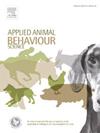强化笼饲养对妊娠和哺乳期母兔后代行为和生产性能的影响
IF 2.2
2区 农林科学
Q1 AGRICULTURE, DAIRY & ANIMAL SCIENCE
引用次数: 0
摘要
在哺乳动物中,宫内经历和早期生活条件会影响未来的行为。本研究旨在评价妊娠期和哺乳期家兔强化笼和常规笼对第一代子代行为和生产性能的影响。采用2 × 2因子试验设计,共16只白新西兰犬。在妊娠期和哺乳期的最后三分之二(出生至第35天),将这些母鼠分别饲养在强化或常规笼中,分为强化-强化(E-E)、强化-常规(E-C)、常规-强化(C-E)和常规-常规(C-C)四种处理。确认怀孕后(交配后10天)进入研究。接近分娩时,于妊娠第28天将它们转移到各自治疗组的笼子中。传统的笼子尺寸为80x60x40厘米,而强化的笼子是8倍大,有隐藏区域,休息平台,站立空间和锯末盒。第35天断奶后,将幼鼠转移到常规笼中。在90日龄时,从每窝随机选择两只母鼠进行行为测试(n = 32):开放场地、新物体、新物体识别和社会互动。观察到的行为用混合线性回归进行分析,以评估治疗的效果。在新的物体识别测试中,与在传统笼子中饲养的后代相比,在妊娠期间饲养在强化笼子中的后代与物体互动的潜伏期减少;然而,在其他测试中测量的行为中没有看到其他影响。哺乳期生活在丰富环境中的母鹿的后代表现出更高的快乐跳跃频率。与传统饲养组相比,他们与物体的互动也更少。在性能方面,在强化笼中饲养的后代在断奶时比在常规笼中饲养的后代在任何阶段都重。然而,与常规组相比,在妊娠期间暴露于环境富集的组断奶后代的数量较低。本研究强调了环境在妊娠期和哺乳期的重要性,表明这些阶段对后代的行为和表现有显著影响。虽然怀孕期间强化的住房对后代的某些行为有积极影响,但它似乎对断奶小猫的数量有负面影响。出生后,环境丰富影响探索、好奇心和体重增加。本文章由计算机程序翻译,如有差异,请以英文原文为准。
Behavioral and performance effects on female offspring from rabbit does housed in enriched cages during gestation and lactation
In mammals, intrauterine experiences and early-life conditions can influence future behaviors. This study aimed to evaluate the impact of enriched and conventional cages for rabbit does during gestation and lactation on the behavior and performance of the first generation of offspring. A 2 × 2 factorial experimental design was used, with 16 White New Zealand does. During the last two thirds of gestation and lactation (birth to day 35), the does were housed individually in either enriched or conventional cages, resulting in the following four treatments: enriched-enriched (E-E), enriched-conventional (E-C), conventional-enriched (C-E), and conventional-conventional (C-C). Does entered the study after pregnancy confirmation (10 days after mating). Close to partum, on the 28th day of gestation, they were transferred to the cages assigned for their respective treatment group. Conventional cages measured 80x60x40 cm, while enriched cages were eight times larger, with hiding areas, resting platforms, space to stand, and a sawdust box. After weaning on day 35, the offspring were transferred to conventional cages. At 90 days of age, two females from each litter were randomly selected for behavioral tests (n = 32): open field, novel object, novel object recognition, and social interactions. The observed behaviors were analyzed using mixed linear regression to assess the effects of the treatments. Offspring from does housed in enriched cages during gestation had a reduced latency to interact with the object in the novel object recognition test compared to offspring from does housed in conventional cages during gestation; however, no other effects were seen in the behaviours measured in the other tests. Offspring of does housed in enriched environments during lactation exhibited a higher frequency of joy jumps. They also interacted less with the object compared to the conventional reared group. Regarding performance, offspring reared in the enriched cages weighed more at weaning compared to offspring reared in conventional cages in any phase. However, the number of weaned offspring was lower in the group exposed to environmental enrichment during gestation, compared to those of the conventional group. This study highlights the importance of the environment during gestation and lactation for does, showing that these stages significantly influence the behavior and performance of the offspring. While enriched housing during pregnancy positively influenced some behaviors of the offspring, it appeared to have a negative effect on the number of kittens weaned. After birth, environmental enrichment impacted exploration, curiosity, and weight gain.
求助全文
通过发布文献求助,成功后即可免费获取论文全文。
去求助
来源期刊

Applied Animal Behaviour Science
农林科学-行为科学
CiteScore
4.40
自引率
21.70%
发文量
191
审稿时长
18.1 weeks
期刊介绍:
This journal publishes relevant information on the behaviour of domesticated and utilized animals.
Topics covered include:
-Behaviour of farm, zoo and laboratory animals in relation to animal management and welfare
-Behaviour of companion animals in relation to behavioural problems, for example, in relation to the training of dogs for different purposes, in relation to behavioural problems
-Studies of the behaviour of wild animals when these studies are relevant from an applied perspective, for example in relation to wildlife management, pest management or nature conservation
-Methodological studies within relevant fields
The principal subjects are farm, companion and laboratory animals, including, of course, poultry. The journal also deals with the following animal subjects:
-Those involved in any farming system, e.g. deer, rabbits and fur-bearing animals
-Those in ANY form of confinement, e.g. zoos, safari parks and other forms of display
-Feral animals, and any animal species which impinge on farming operations, e.g. as causes of loss or damage
-Species used for hunting, recreation etc. may also be considered as acceptable subjects in some instances
-Laboratory animals, if the material relates to their behavioural requirements
 求助内容:
求助内容: 应助结果提醒方式:
应助结果提醒方式:


